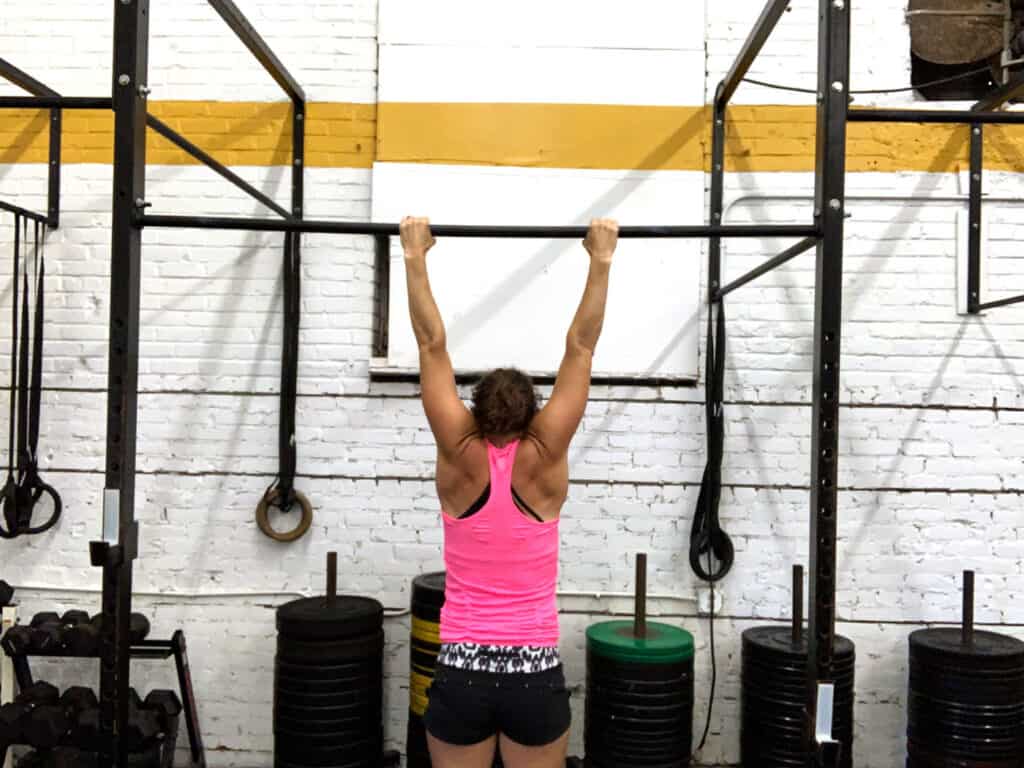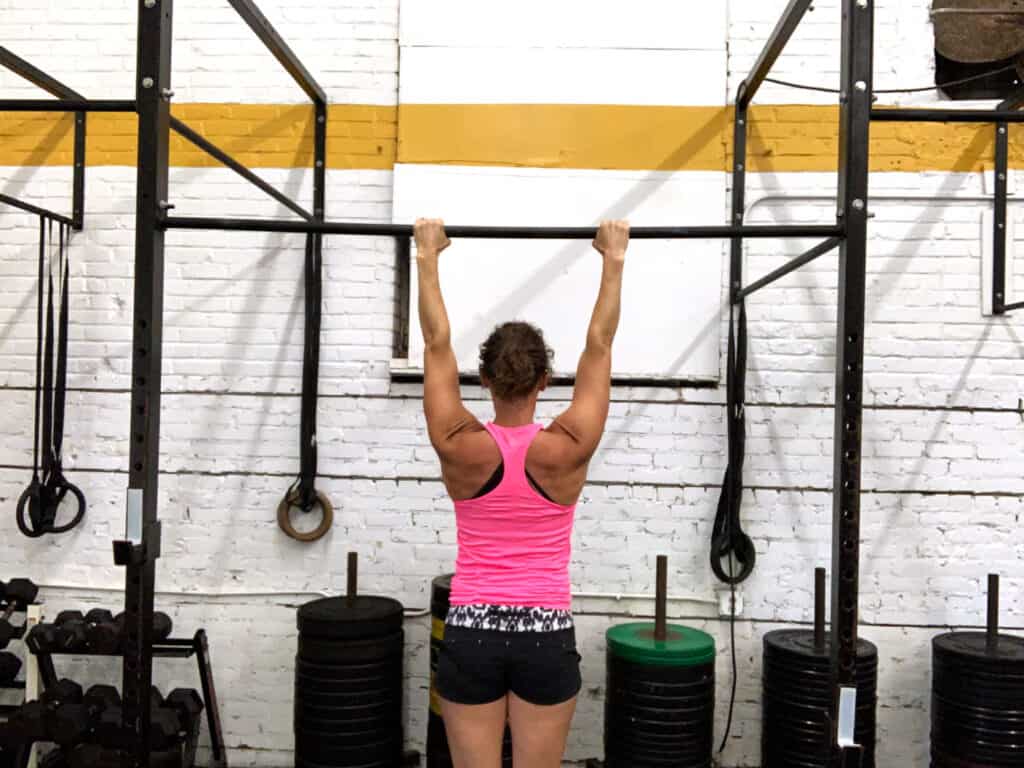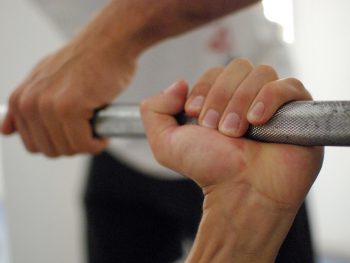
Toes to bar (T2B) is one of the main gymnastics movements commonly used in CrossFit that is exactly like it sounds – while hanging from the pull-up bar, you bring your toes to – you guessed it – the bar.
They are a great exercise that build shoulder strength and work your core muscles, especially your lower abs. It’s not as simple as it sounds, though. Have you ever laid on the ground and done leg raises, like this?

It’s a lot of ab work! So are T2B. You need a strong core, strong hip flexors, a stable shoulder, and a tight grip to master this gymnastic movement.
Strong core
Let’s start with the strong core. There are multiple exercises you can do to train a strong core that have similar movement patterns to toes to bar. These will not only get you strong, they will help you understand how this movement works.
Here are 4 exercises you can do to get ready for toes to bar:
- Toes to Rig
- Toes to KB
- Dragon’s Tail
- Lying Banded Lat Pull Downs
- Hollow Hold / Hollow Rocks
Toes to rig

To complete toes to rig, lie down flat on the ground with the rig behind your head. You want to be far enough away from it that when you reach your arms overhead, they are straight, or close to it.
From there, reach your hands over your head and hold onto the rig. Pull your belly button to your spine, then lift your legs up and reach them overhead towards the rig.
You can start low – as you gain more experience, stand next to the rig and mark your shoulder height, then use that mark as the target for your toes. It will seem high, for good reason! You’re working towards a similar reach for toes to bar.
Toes to KB

Toes to kettlebell are another great way to learn how to do toes to bar. Lie on the ground with the kettlebell overhead and arms straight.
Hold onto the handle, press your bellybutton to your spine, and lift your legs up and reach them overhead for the kettlebell.
On the descent, keep your legs slow and controlled as you lower them back down to the ground.
Dragon’s Tail


Sometimes called dragon flags as well, dragon’s tails require a LOT of core strength. For a dragon’s tail, lie down on the ground and reach overhead to hold onto the rig.
Keeping your core tight, reach your legs up in the air and straight overhead. Then begin to lower your legs as slowly as possible, keeping your body in a straight line as much as possible.
When you first start these, you will probably find that your legs plummet to the ground pretty quickly. That’s ok! Keep working on them. The more you do them, the more slow and controlled they will get.
Lying banded lat pull downs

Lying banded lat pull downs not only work your core strength for toes to bar, but also your lats. Lats are essential in learning how to do toes to bar.
Loop a band around the rig and through itself, and pull it tight. Lie down on the ground and reach overhead to grab ahold of the band.
Your grip should be just outside of shoulder width. Keep your arms straight, lift your head up off the ground, pull your bellybutton to your spine, and lift your feet off the ground.
Then press down with your hands, keeping your arms straight, until the band is in your lap.
Release the band back up overhead, slow and controlled, being careful not to let it snap back on you.
Stable shoulder
After a strong core, the next thing you need to learn how to do toes to bar is a stable shoulder.
Holding a strong plank position will help build not only a strong core but also a stable shoulder.
The next thing you’ll need to work on is being able to engage an active shoulder, and then moving through those motions fluidly for scap pull ups.
Active shoulder
Active shoulder means that the muscles around the shoulder are engaged and the joint is stable. You create an active shoulder by starting from a hanging position on the bar, then think about pulling your shoulders down and away from your ears. You can also think about trying to put your shoulder blades in your back pockets if you were wearing jeans.


This motion will cause you to engage the muscles in your shoulders and lats, creating a stable base for you to begin to learn how to do toes to bar.
Keep in mind that your arms should stay straight for this, and there should be no bend in the elbows. If your elbows bend, it means you’re pulling a little with your arms. You need to be able to keep an active shoulder the entire time you’re on the bar.
Here’s what scap pull ups look like when done correctly:
Strict before kip
Kipping is a technique where you use momentum to generate force and make the movement easier and faster.
With any gymnastics movement, you always want to make sure you can do the movement strict before trying to kip. This This is the best way to ensure we have enough base strength to do the movement safely when adding force, and will make us stronger in the long run.
How to learn strict toes to bar
Start by jumping up on the pull up bar and holding on. This will build grip strength! Once you can hold on, and can maintain an active shoulder, keep your feet together and practice hanging leg raises.
Start by pulling your knees up like you’re sitting in a chair, then straightening your legs straight below you. Continue this motion, trying to eliminate any swing from the movement.

If you feel like you’re starting to swing too much, drop down, then jump back up when you’re ready.
Once your hanging knee raises feel strong, try lifting your legs straight out in front of you, so you are in the shape of an L, like this:

Once these feel strong, you just need to get your toes to the bar!
Keep lifting your legs, keeping them straight. Lean your head back slightly while you bring your feet up until they touch the bar, then lower them.
How to kip
Once you’ve got strict toes to bar, the next step of the progression is the kip. The first step to kipping is to learn the arch and hollow body positions. Arch and hollow are covered in detail in this post! (They are also sometimes referred to as your banana and superman positions, because of the shapes you are making with your body.)
Start on the pull up bar with an active shoulder. From there, think about pulling your head and chest back, rounding your upper back, and imagine yourself pushing down on the bar to push it into your lap if you could.
You will keep your eyes straight ahead and push your body behind the plane of the bar. This is your hollow body position.
From there, think about sticking your chest and head out towards the wall in front of you as far as you can, and pulling your feet back behind you while keeping your legs straight. This is your arch position. Here’s what those look like when done correctly:


Work on these positions until you can move easily between them. Arch-hollow, arch-hollow. This movement is mostly coming from your lats. If you feel like you’re losing the rhythm, go back to the previous step and begin again.
Once you have a strong kip, start pulling your knees to your chest in the hollow position. The more you push DOWN on the bar, the higher you will go! Keep your abdominal muscles strong and core tight.
When you are in your hollow position, with your knees to your chest, flick your feet and tap the bar with your toes. This is your first rep! Repeat for the next rep, as many times as you can.
Below is a video that will show you the following progression:
Strict toes to bar, kip swing, knees to elbow, kipping toes to bar.
This is the order you should learn these movements in and begin to piece them together!
If you feel like you’re staying under the bar and looking up at the ceiling, the next time try keeping your eyes on the horizon for the entire movement. If you feel like after a few reps you start swinging out of control, you need to go back and work on the timing of your kip. A good kip and hitting the full range of motion in both the arch and hollow are the keys to fluid motion in the toes-to-bar exercise.
Bent legs vs. straight legs
When learning how to do toes to bar, try as much as possible to keep your legs straight.
You may see some people complete toes to bar with bent knees, both when they reach them for the bar and when they bring their legs down. This is typically something that occurs due to lack of hamstring flexibility, so make sure to focus on your mobility and stretching too!
Keeping your legs straight is a more traditional gymnastics style, as well as being smoother and more efficient.
Feet together
Speaking of being smoother and more efficient, try to keep your feet together. You may see some people separate their feet and let them splay out behind them when they are in the arch position. This wastes energy and time!
Keeping everything together and tight in one straight line is the most effective method for moving ourselves through time and space.
Tight grip
If you have both a strong core and a stable shoulder, but are still struggling to hold on to the bar, you may need to work on your grip strength.
In our post “A Strong Grip: Why We’re Losing It and Why It Matters,” we cover how over time, we’re losing our grip strength as a species.
Many functional fitness movements incorporate grip – since we don’t use many machines, we often have to hold on to handles, barbells, or pull up bars.
Exercises like kettlebell swings, deadlifts, and more all incorporate grip strength into your workout.
It doesn’t have to be complicated. If you want to work on your grip strength, just jump up onto the pull up bar and hang on. See how long you can hold before you have to let go.
Keep doing this each day, and you’ll build up grip strength and be able to hold on longer and longer each time.
Combine your grip strength, your strong core, and your stable shoulders, and you’ll learn how to do toes to bar in no time.













 How To Do A Proper Push Up
How To Do A Proper Push Up